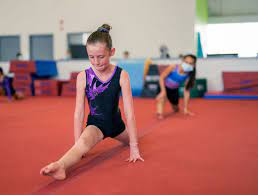Gymnastics for kids is one of the most effective ways to support a child’s overall development—physically, mentally, and socially. Backed by decades of research and embraced by health professionals, gymnastics helps children build strength, coordination, confidence and social skills, all while having fun. It’s more than just forward rolls and cartwheels; it’s a foundation for lifelong healthy habits and learning.
What makes gymnastics so valuable for childhood development?
Gymnastics for kids offers a blend of structure, challenge, and creativity. As children learn to balance, jump, and swing, they’re not just burning energy—they’re developing core physical and cognitive abilities.
Some of the key benefits include:
- Gross and fine motor skill development
- Body awareness and spatial control
- Improved balance, strength, and flexibility
- Discipline and focus from structured routines
- Social interaction and cooperative learning
These areas are crucial for school readiness, emotional regulation and confidence during formative years.
How does gymnastics improve physical health in children?
Children who participate in gymnastics naturally develop better fitness. They engage every major muscle group during a typical class, which improves cardiovascular endurance, flexibility, and muscular strength—especially in the upper body and core.
More importantly, gymnastics trains body control and coordination at a young age, which:
- Reduces risk of injury in other sports
- Lays the foundation for advanced athletic skills
- Encourages active habits that can reduce sedentary lifestyles
As Gymnastics Australia notes, gymnastics is one of the most comprehensive forms of exercise for young bodies because it develops strength and movement literacy in tandem.
Does gymnastics help with learning and behaviour?
Yes—through both brain and behavioural development. Many parents and educators observe that children in gymnastics demonstrate improved classroom behaviour. The reason? Gymnastics nurtures essential executive function skills like attention control, memory, and discipline.
Here’s how it works:
- Routine-based learning helps kids follow instructions and build memory pathways
- Problem-solving during obstacle courses encourages cognitive flexibility
- Sequential movement links to early maths and reading comprehension
One study even found that kids involved in structured movement programs like gymnastics perform better on standardised academic tests in early primary years.
Can gymnastics improve a child’s social confidence?
Absolutely. Group-based gymnastics for kids creates a space where they learn cooperation, turn-taking, and respect for others. The environment encourages positive social interaction without the high-pressure competitiveness that comes with many team sports.
Key social advantages include:
- Learning to cheer others on and celebrate progress
- Developing a sense of belonging in a non-judgemental space
- Practising communication with coaches and peers
For shy or introverted children, gymnastics can be a low-barrier way to build social confidence over time.
At what age should kids start gymnastics?
Children as young as 18 months can begin in parent-assisted classes that focus on play-based movement. From around age 4, many kids graduate to independent beginner classes. This is typically when you see the most significant leaps in skill and confidence.
Importantly, gymnastics is scalable. Kids can start at any age and still gain benefits, whether they’re five or ten. What matters more is consistency and enjoyment, not early specialisation.
Why is consistency in gymnastics so important?
Just like with reading or swimming, consistent practice reinforces skill retention. The more a child engages in gymnastics, the more they internalise discipline, improve coordination, and gain muscle memory.
From a developmental standpoint, routine participation teaches:
- Persistence and goal-setting
- Resilience after falls or setbacks
- Pride in personal progress
This aligns with Cialdini’s principle of Consistency: when children commit to something regularly, they start seeing themselves as someone who follows through—reinforcing healthy self-identity.
What are some signs your child will benefit from gymnastics?
While every child can benefit, you might notice specific indicators that gymnastics could be especially helpful:
- They’re high energy and need structured outlets
- They struggle with balance, focus or coordination
- They enjoy climbing, rolling, or bouncing
- They could benefit from confidence-building in group settings
Parents often report better sleep, mood, and attention spans in kids who start gymnastics even once per week.
Is gymnastics a safe activity for young children?
Safety is a priority in all legitimate gymnastics programs. Coaches are accredited and equipment is designed for child-sized use. The sport teaches controlled movement and how to fall safely, which can actually prevent injuries in other areas of life.
Plus, with small class ratios and skill-level grouping, each child progresses at their own pace—making it both safe and developmentally appropriate.
FAQs
Is gymnastics suitable for children with learning differences?
Yes. Many gymnastics programs are inclusive and offer adaptations for children with ADHD, autism or sensory processing differences. The structure, repetition, and focus on individual progress often suit neurodivergent learners.
How often should my child attend gymnastics?
For most kids, 1–2 sessions per week is a good starting point. This balance allows for progress without burnout and works well alongside other sports or school commitments.
What should my child wear to their first gymnastics class?
A fitted T-shirt and shorts or leggings are ideal. Avoid anything baggy or with zips. Most venues ask children to go barefoot for safety and grip.
Conclusion
Gymnastics for kids is more than a sport—it’s a smart developmental investment. It builds strength, confidence, focus, and social skills through movement and play. Whether your child is naturally athletic or still finding their feet, gymnastics offers a balanced, engaging way to support their growth in body and mind.
For those curious about available gymnastics programs, it’s worth exploring your local options to find a class that matches your child’s age and energy.

